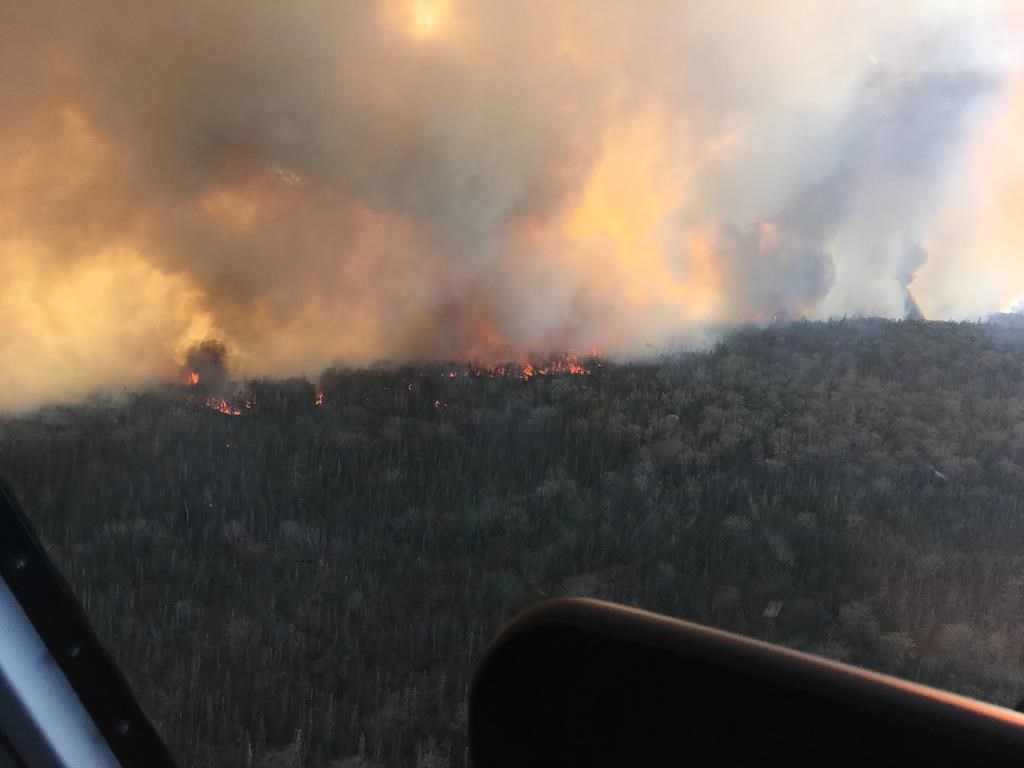Hot, dry weather is continuing to pose a challenge for crews fighting out-of-control forest fires in Nova Scotia.

As of Wednesday afternoon, there were 14 active wildfires burning in Nova Scotia, three of which are out of control.
In the Tantallon and Hammonds Plains area of Halifax, a 837-hectare wildfire has destroyed 151 homes and forced the evacuation of more than 16,000 people.
On Wednesday evening, the evacuation order for the Indigo Shores subdivision was lifted. Residents were allowed to re-enter the area around 7:30 p.m. The only access point to the subdivision is through Margeson Drive, and residents must have identification showing their address.
However, Halifax Regional Municipality said people must remain on alert because the fire is still active in the area and residents are on a 30-minute evacuation notice for now.
In southwestern Nova Scotia, a massive fire at Barrington Lake in Shelburne County now measures around 17,600 hectares. About 50 residences have been destroyed, and 5,000 people have had to flee.
And a much smaller wildfire that started Monday in nearby Pubnico now measures at just over 160 hectares.
During a news conference Wednesday afternoon, David Steeves, a technician of forest resources with the Department of Natural Resources and Renewables, said the current weather is “not a good news story” for those working to get the fires under control.
The temperature in the Halifax area was 25 degrees Wednesday, coupled with 20 per cent humidity. When the humidity levels are lower than the temperature, said Steeves, that’s an indicator of “extreme fire behaviour.”
“That is evident in some of the areas that our firefighters are being tasked today,” he said.
The fine fuels – leaves, twigs, and other “really small fuels” littering the forest floor – are “extremely dry,” said Steeves, making the fire easier to spread.
“The fact that we have large spread rates today makes it very dangerous for the folks in the field,” he said.
According to Environment Canada, temperatures are expected to reach a high of 32 degrees in the Halifax area Thursday, and 22 degrees in the Shelburne region.
Some hope could be coming later this week – there’s a 60 per cent chance of showers Friday, with rain forecasted for Friday evening and Saturday.
‘Be ready for a long firefight’
Dave Meldrum, deputy chief with Halifax Regional Fire and Emergency, said earlier in the day that the devastation left by the Tantallon wildfire is a “site of tragedy.”
“There’s widespread destruction, and at the same time, there’s a level of randomness that comes with wildfires when they hit the urban interface where people live,” he said.
“So there are properties that are unharmed in close proximity to properties that are destroyed.
“It’s terrible to see. These are people’s homes. This is a community, and it’s really confusing to myself, as a layperson and a resident of the regional municipality, to see how this community was impacted by this fire.”

He could not speculate about when the fire would be under control.
“I would encourage all of us to be ready for a long firefight,” he said.
“We’ve got a lot of dry weather days ahead. We’ve got low humidities forecasted. This is going to be a prolonged operation.”
While a specific cause of the fires are still unknown, DNRR officials believe they were caused by people, as are most wildfires.
The Department of Natural Resources and Renewables has issued a total burn ban across the province, and Nova Scotia Premier Tim Houston announced Tuesday that the province is implementing a ban on travel and activity in the woods.
A number of heavily wooded parks in the Halifax area have been closed, including Shubie Park, Point Pleasant Park and Admiral Cove Park. However, non-wooded areas of municipal parks, such as greenspaces, playgrounds, sports fields and ball diamonds will remain open for use.
Houston said Thursday that effective immediately, anyone who burns in the province could be subject to a fine of $25,000. The premier has also requested federal aid.
Help available through Red Cross
In a release Wednesday, the Atlantic chapter of the Canadian Red Cross said households in Nova Scotia who had to leave their primary residence due to evacuation orders could be eligible to a one-time payment of $500 in emergency financial aid.
The funds are from the province but are being administered by the Canadian Red Cross. Premier Tim Houston first announced the program Monday.
According to the Red Cross release, only one application and payment per household is permitted, and the household must have been evacuated from their primary home by order from a municipality or from police, fire or local or provincial emergency management officials.
People can apply to receive the funds online or by calling 1-800-863-6582 between 8 a.m. and 8 p.m. daily.
The Red Cross has also launched a Nova Scotia and Atlantic Canada fires appeal, “allowing Canadians to contribute funds to help the most impacted people from affected areas.
“The extent of that support will only be known once there is a clearer picture of needs and of how much money will be raised,” the release said.
The appeal is separate from the emergency $500 payments delivered on behalf of the Nova Scotia government.
Those who wish to make a donation to the appeal can do so online or by calling 1-800-418-1111.










Comments